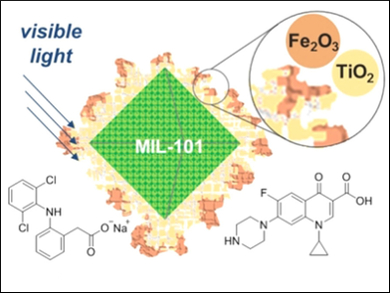In the drive to develop sustainable technologies, it is important to use earth-abundant materials as a cheaper and more environmentally friendly alternative to precious metals. This is key, for example, in wastewater treatment, where metal-based catalysts can be used to prevent the increasing accumulation of harmful organic compounds from medical or industrial waste.
Rhett Kempe, University of Bayreuth, Germany, and colleagues have developed a photocatalyst, in which crystalline TiO2 and Fe2O3 are deposited on the surface of crystallites of the metal-organic framework MIL-101(Cr). The team used gas phase infiltration procedures with titanium(IV) isopropoxide and iron(0) pentacarbonyl as precursors and subsequent metal oxide formation to synthesize the desired Fe2O3/TiO2@MIL-101 catalyst.
As a model for the treatment of clinical wastewater, the photocatalyst was used to degrade pharmaceutical compounds in aqueous solution. The photocatalyst exhibited better activity than Fe2O3@MIL-101, TiO2@MIL-101, and the commercially available TiO2 (P25) photocatalyst. In addition, minimal loss of activity was noted after five successive runs. These results could help to develop design strategies for noble-metal-free photocatalysts for clinical wastewater decontamination.
- A Metal-Organic Framework Supported Nonprecious Metal Photocatalyst for Visible-Light-Driven Wastewater Treatment,
Dominic Tilgner, Martin Friedrich, Andreas Verch, Niels de Jonge, Rhett Kempe,
ChemPhotoChem 2018.
https://doi.org/10.1002/cptc.201700222




